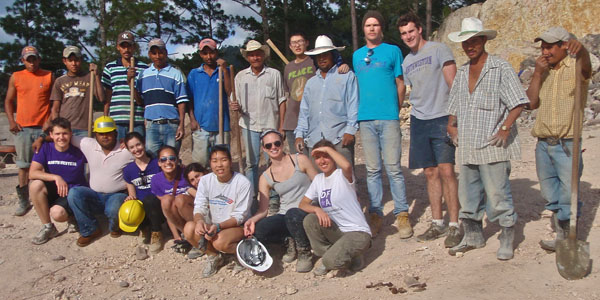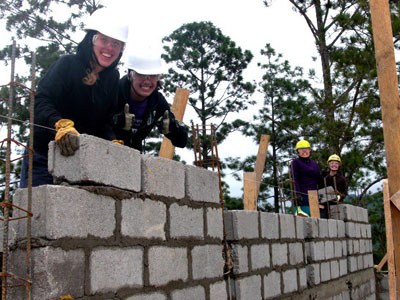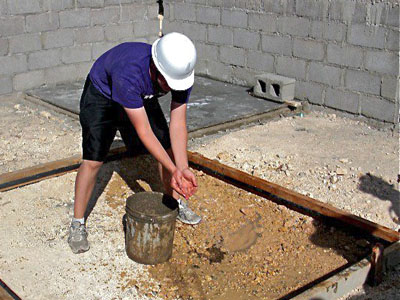Global Architecture Brigades Students Build School in Honduras

It began with an email: Would you like to be part of Global Architecture Brigades? Yes, said McCormick civil engineering students Mehri Paydar and Elif Koru, who had lamented the lack of architecture student groups on campus. So in late 2009, they created a Northwestern chapter of the international student organization and recruited students to join.
But in the end, they got more than just a community of like-minded peers: they and seven other students spent a week of their winter break on a mountain in Honduras, cutting rebar with hacksaws and mixing concrete with shovels, building a new elementary school for a local village.
“It was eye-opening,” said group member Frank Cummins. “Every night I would lie in bed and look out the window and think about what I’d done that day. I got a lot of satisfaction from that.”
Global Brigades is the world’s largest student-led global health and sustainable development organization. One of its programs, Architecture Brigades, offers students a way to design and construct socially responsible and sustainable architecture solutions in Honduras.
After establishing the chapter at Northwestern, both Paydar and Koru, students in McCormick’s Architectural Engineering and Design program, realized they wanted the group to be more than a volunteer trip — they wanted to provide a community for students interested in architecture. They organized activities like design charrettes, where students were given a design problem to solve.
“We just spent a couple hours and tried to think of as many ideas as we could,” Paydar said “We came up with some good designs and just had fun.”
But they quickly focused on fundraising for the group’s ultimate purpose — a seven-day brigade to Zurzular, Honduras, where they were charged with helping to build a new school. (Students also have the option of entering contests to help design GAB’s buildings, but the Northwestern chapter did not have time to create an entry.) Through individual and group efforts (and a donation from member Frank Cummins’ church), nine students raised enough money to go. Days after finishing up their fall quarter, they flew to Honduras and found themselves riding in a van up a Honduran mountain to the school construction site.
The landscape was paradise — mountains and sugar cane fields as far as they could see — but the need for a new school in the impoverished village was evident. The current school was small, making education beyond the sixth grade unfeasible. It had no courtyard for students to gather, and it had a tin roof that made class impossible during rainstorms.
 Construction on the new school was already begun by a brigade before them, and the students were helped by a bevy of local volunteer fathers. (The organization’s deal with the village: if you want your students to attend this school, you have to help construct it.) For the next five days, the students went about laying floors, building cinderblock walls, mixing concrete and cutting rebar — something both Koru and Paydar became experts at.
Construction on the new school was already begun by a brigade before them, and the students were helped by a bevy of local volunteer fathers. (The organization’s deal with the village: if you want your students to attend this school, you have to help construct it.) For the next five days, the students went about laying floors, building cinderblock walls, mixing concrete and cutting rebar — something both Koru and Paydar became experts at.
“We were the smaller ones, and we were sent to cut rebar with a hacksaw,” Koru said. “And we did it. We were in the dirt, sawing the rebar, and it was cold and windy, but we did it.”
“We have biceps now,” Paydar laughed. “They didn’t cut us any slack.”
Frank Cummins, a biomedical engineering sophomore, spent much of his time hand-mixing cement with filtered dirt from the local riverbed.
“It gets heavy pretty quickly,” he said. “It was exhausting work.”
Each student pulled from whatever Spanish they knew to talk with the fathers, who, to their relief, were welcoming.
“I didn’t want it to seem like we were coming in to take over,” Koru said. “But they were all really friendly.”
At night, they took the hour-and-a-half van ride back down the mountain (before dark, as there are no lights along the road) and ate their daily dinner of beans and rice. They spent their evenings talking with the GAB coordinator who designed the school.
“He told us how he created the design, why he chose certain building techniques for the village, and what plans he was working on next,” Paydar said. “It was a really great learning and interactive experience.”
On the final day, the students visited a local orphanage to play with the children, and drank local coffee at one of the volunteers’ homes.
"Meeting the residents on the fourth day of our trip was an especially rewarding experience,” Koru said. “Seeing the kind welcome of the community helped us to connect the dots and see the impact that we were making."
 By the time they headed back home for winter break, the students had built most of the walls and laid most of the floor.
By the time they headed back home for winter break, the students had built most of the walls and laid most of the floor.
“We accomplished our goals for the week,” Paydar said. “Everybody worked really well together.” For Koru and Paydar, the experience provided another angle from which to approach their winter quarter concrete class.
“It contextualized our academic experiences,” Paydar said.
For Cummins, the experience galvanized him to lead the group forward to help build and design for developing communities.
“I now have a greater will to help developing communities like this in the future,” he said. “I hope our group will grow so we can do even more.”
To find out more information on the group, email NorthwesternGAB@globalbrigades.org.